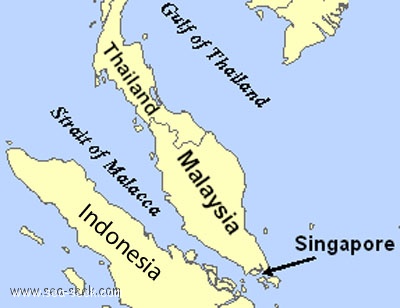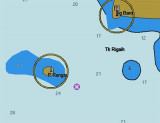
Tanjung Piandang to Port Kelang (Malaysia)
These mangroves are generally creeping seaward as the deposits from the muddy creeks increase.
Extensive mud ...
| Latitude | Longitude | |
| DMS | --- | --- |
| DM | --- | --- |
| DD | --- | --- |


Ebook | Strait of Malacca (East)
|
 The Strait of Malacca is a narrow, 805 km stretch of water between the Malay Peninsula (Peninsular Malaysia) and the Indonesian island of Sumatra.
The Strait of Malacca is a narrow, 805 km stretch of water between the Malay Peninsula (Peninsular Malaysia) and the Indonesian island of Sumatra.Singapore Strait is the area lying between the S coasts of Malaysia and Singapore Island on the N side and the coast of Sumatera on the S side.
The Strait of Malacca and Singapore Strait together form the main seaway connecting the Indian Ocean with the South China Sea. The straits offer the shortest route for tankers between the Persian Gulf and Japan.
The strait is the main shipping channel between the Indian Ocean and the Pacific Ocean, linking major Asian economies such as India, China, Japan and South Korea. Over 50,000 vessels pass through the strait per year carrying about one-quarter of the world's traded goods including oil, Chinese manufactures, and Indonesian coffee.
Malaccamax is a naval architecture term for the largest size of ship capable of fitting through the 25 metres (82 ft)-deep Strait of Malacca.
Shipping hazards:
Piracy in the strait has risen in recent years. There were about 25 attacks on vessels in 1994, 220 in 2000, and just over 150 in 2003 (one-third of the global total). After attacks rose again in the first half of 2004, the Malaysian, Indonesian and Singaporean navies stepped up their patrols of the area in July 2004. Subsequently, attacks on ships in the Strait of Malacca dropped, to 79 in 2005 and 50 in 2006.
There are 34 shipwrecks, some dating to the 1880s, in the Traffic Separation Scheme (TSS), the channel for commercial ships. These pose a collision hazard in the narrow and shallow Strait.
Another risk is the yearly haze caused by raging bush fires in Sumatra. It can reduce visibility to 200 metres (660 ft), forcing ships to slow down in the busy strait. Ships longer than 350 metres (1,150 ft) routinely use the strait.
Along the N coast of Sumatera, the Southwest Monsoon prevails from about April to November and the Northeast Monsoon from about November to April.
During the Southwest Monsoon the wind frequently holds both day and night near Ujung Raya, while farther E it is not so permanent.
In the strength of the Northeast Monsoon, the wind blows from E to NE from about 1000 to 1600, strengthening near the close. It then begins to drop and is usually calm about sundown; there is a land breeze during the night. In April, SW and W winds begin; the Southwest Monsoon is established in May.
Waterspouts are seen off the coast at times.
At the N and NE portion of Sumatra, during the Northeast Monsoon, there is generally a swell on the coast, which gives rise to a considerable sea in the afternoon, if accompanied by a stiff sea breeze. Both subside quickly, so that the water is generally smooth at night and in the forenoon.
At times, the monsoon blows strongly for some days, at which times communication with the shore is reported impracticable.
December and January, are usually the worst months.
The Southwest Monsoon is the best for landing on this portion of Sumatera.
Although the Strait of Malacca is within the limits of the NE and Southwest Monsoon of the Indian Ocean, on account of the high land on either of the strait, the winds are variable.
However, land and sea breezes are regular on both coasts.
In the Strait of Malacca to the W of the islands N of the N Sumatera coast, there is a current setting in a W direction, often attaining a rate of 1.5 to 2 knots, and inclining N or SW by the action of the prevailing monsoon.
Between these islands and the Nicobars, during the strength even of the Southwest Monsoon, there is frequently a current that sets directly into the monsoon at a rate of 2 knots.
At the same period there is said to be a strong current between Pulau Weh and 6°30'N, setting E as far as the meridian of Tanjung Jambuair. This current is said to continue all the year around, but with less strength during the Northeast Monsoon.
It is to be regarded as a countercurrent with reference to the W current along the coast from the Strait of Malacca.
Through the Strait of Malacca there is a constant NW set, but near the S, where the strait is considerably narrower, it is only felt by its action on the tidal current, decreasing the velocity of the flood current and almost overcoming it during neaps, and increasing that of the ebb to the same extent.
In the NW portion the same effect is produced near the shore on the tidal currents, but out in the middle of the strait it is fairly constant and strongest during the Northeast Monsoon; it finally makes its way seaward along the coast and affects the tidal current there, as above mentioned.
The tidal action is not appreciable beyond the distance of about 8 miles off the Pedir coast and about 40 miles off the E coast of Sumatera.
The flood sets E on the N coast of Sumatera and the ebb W, rarely exceeding 2 knots at spring; at neaps they are sometimes imperceptible, except at the points or over banks and narrow channels.
The currents are also affected by the constant current out of the Strait of Malacca, which takes a W direction along the N coast, through the passages S of Pulau Weh, so that for the greater part of the year the ebb current is longer and stronger than the flood current.
The prevailing winds as a result of which, when the water is rising or falling during the Northeast Monsoon, there may be no E set for a day or more; conversely, the flood or E current runs long and stronger during the Southwest Monsoon.
The overall set in the strait is to the NW, but from May to September there is a tendency for SE sets to prevail in some N and central parts but the predominance is very slight. On the average, between 50 and 60 per cent of all current observations in the strait are 0.5 knot or less. A small portion of these observations exceed 2 knots.
In the N part of the strait, the general directions of the tidal currents are SE and NW. The SE stream reaches maximum rate about 1 hour prior to HW and the NW current reaches maximum rate about 1 hour before LW.
In the main fairway, the spring rates are about 1.5 knots, but may reach 2.5 to 3 knots in the more restricted channels and inshore waters.
The tidal currents in the S end of the Strait of Malacca set SE and NW to and from Selat Durian (1°00'N., 103°35'E.); they are not necessarily associated with any particular currents and may meet or separate from the latter S of Tanjung Piai (1°16'N., 103°31'E.), the S extremity of the Malay Peninsula.
The depths in the Strait of Malacca are generally irregular and a considerable portion of the bottom is of sand wave formation. Depths in the main shipping channels vary from 14.9 to over 100m.
Dangerous sand banks which can restrict navigation are located in both traffic separation scheme lanes of One Fathom Bank (2°53'N., 100°59'E.) and Fair Channel Bank (1°28'N., 103°08'E.).
Areas NW of One Fathom Bank and SW of Tanjung Tuan (Cape Rachado) (2°24'N., 101°51'E.) are subject to sand wave formation. Deep-draft vessels should, therefore, take particular note of the latest depths over shoals lying in or near the fairway.
Caution.—Navigational aids are often unreliable, especially in Indonesian waters. Risk of collision is appreciable due to heavy traffic using the through routes, frequent crossing traffic, and local fishing craft with nets.








